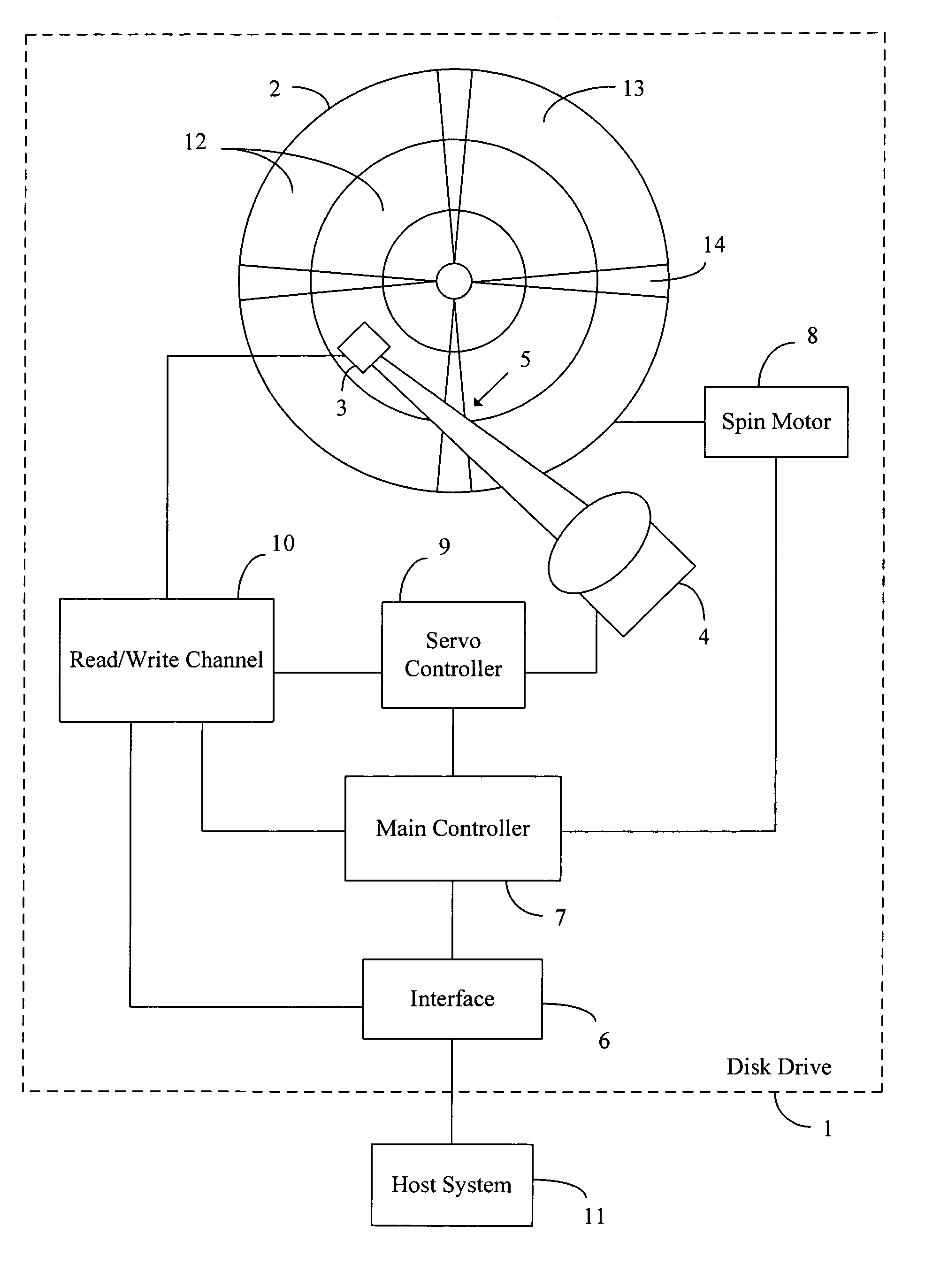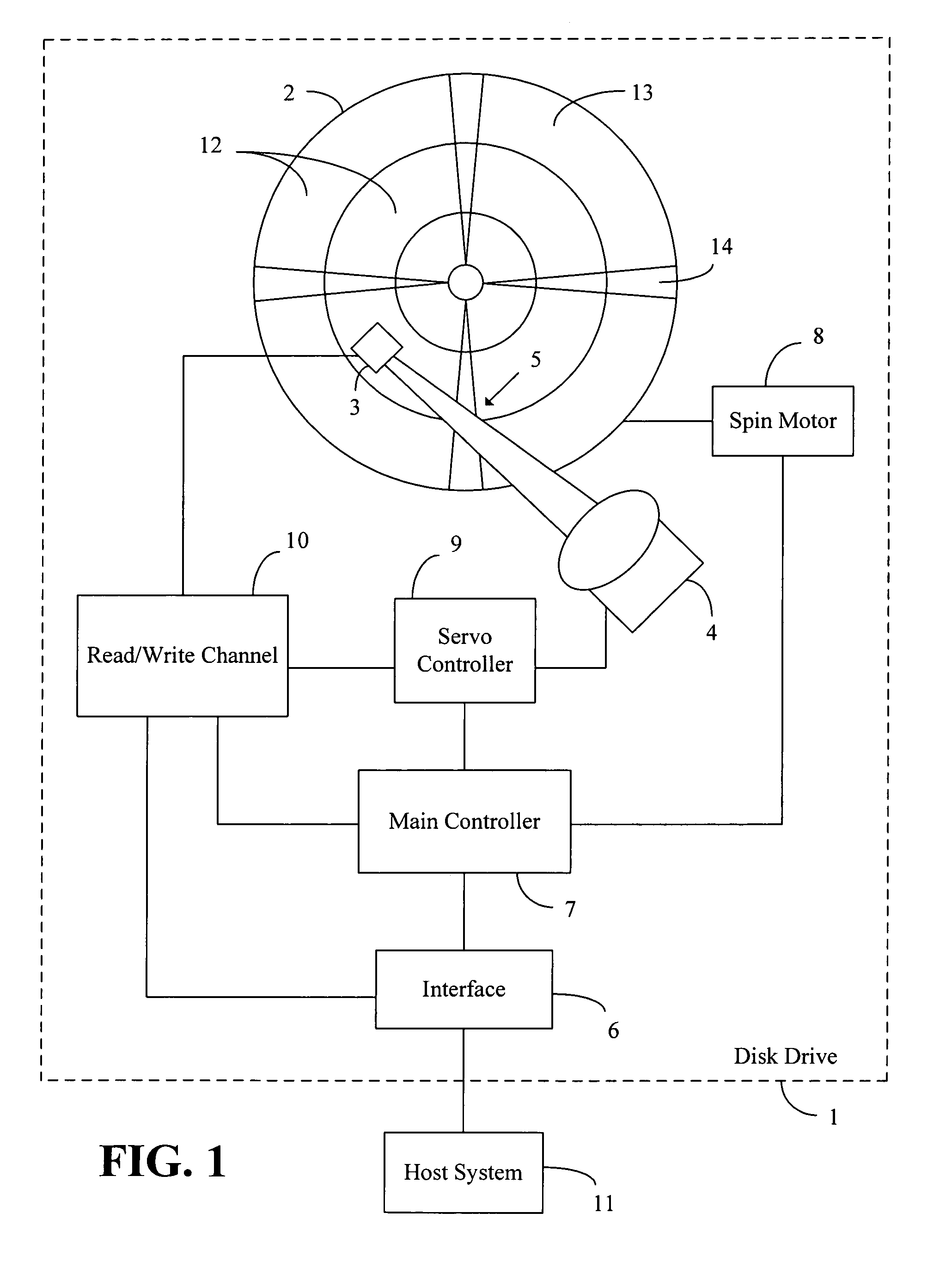More recently, there has been a recognition that when the
mechanical components of a disk drive are moved as quickly as possible to minimize seek time, acoustic
noise is generated that can be annoying and even worrisome to end users.
However, in the related art disk drives, some amount of acoustic
noise is still generated during seek operations that is perceptible and noticeable to human listeners, which has led to
end user dissatisfaction with the disk drives.
By controlling the actuator to move the head with maximum acceleration and deceleration, noticeable levels of acoustic
noise are generated due to vibration introduced to an actuator arm
assembly on which the head is mounted as a result of the instantaneous acceleration and deceleration by the actuator.
Performance seeks also have an issue with
settling time, as they cause the actuator to decelerate fast, and there is no assurance that the head will settle in a stable manner over the destination track.
In general, with performance seek profiles, there is very often an overshoot of the destination track, and time is required for
recovery from the overshoot.
Therefore, while reference 1 is concerned with decreasing velocity and providing for gradual acceleration, reference 1 does not allow for placing a limit on snap, so a rate of change of jerk can be great.
In reference 2, there is noted a
disadvantage of conventional disk drives in that the velocity profile of such conventional disk drives are designed to minimize
access time for random seeks, which is particularly problematic when the disk drives are utilized for storage of Audio Visual / Video (AV) content in AV systems such as
consumer electronics (e.g.
Digital Video Recorders) in which access patterns require non-random seeks that generate significantly higher acoustic noise than random seeks.
However, similar to reference 1, while reference 2 focuses on reducing current and velocity, reference 2 does not disclose placing a limit on snap, so a rate of change of jerk can be great.
However, the disk drives of reference 3 only allow for an automatic use of the low-noise velocity profile, and do not allow for receiving a command from external sources to selectively enable and disable the use of the low-noise velocity profile.
Also, the disk drives in reference 3 have no way to distinguish between seek operations initiated by an
operating system and seek operations initiated by a user.
Furthermore, the seek profiles disclosed in reference 3 allow for rapid changes in acceleration and, thus, both a jerk and a snap of the seek profiles may be great.
Even when employing the silent seek profiles or low-noise velocity profiles of the related art disk drives, a noticeable amount of noise is still produced during seek operations.
For example, when silent seek profiles such as those described in the references are used for seek operations, there may be a level of noise generated during the seek operations that reaches more than 25 decibels (dB).
For example, if a user of a computer with a disk drive leaves the computer on in a room where the user is trying to sleep, there may be very low ambient noise in the room.
Then, if the disk drive begins performing internal
housekeeping operations, such as maintenance or self-diagnostic seeks, while the user is trying to sleep, the user may be very sensitive to any perceptible, extraneous, and uncontrolled noise and, thus, may be very annoyed that the disk drive is generating a noticeable amount of acoustic noise.
Similarly, if a user in a quiet office is trying to concentrate or meditate, and is in deep thought, the user may become frustrated if a disk drive begins generating acoustic noise that is noticeable and interrupts the user's thought process.
Also, there is a similar problem with audio CD systems, where changing a current audio piece causes audible noise when the CD head, which may be a mirror, is suddenly repositioned.
Moreover, if a user notices acoustic noise from a disk drive when the user has not performed an operation involving the disk drive, such as when the disk drive performs self-initiated internal
housekeeping operations, the user may become worried and think that the disk drive has failed.
Such worry or concern may be for no good reason, and may eventually lead the user to wrongly believe that the disk drive is defective and to return the disk drive.
Thus, perceptible noise during seek operations may lead end users to lose confidence in the reliability and
general health of their disk drives.
The disk drives of the related art continue to generate perceptible noise even when employing silent seek profiles, because such silent seek profiles focus on reducing velocity and adjusting acceleration, without focusing on reducing jerk and snap.
A significant part of noise production in disk drives can be attributed to percussions that are due to rapid changes in jerk during a movement of an actuator.
Even though the related art disk drives allow for adjusting acceleration for silent seek profiles, the related art disk drives do not impose a limit on a maximum amount of snap during seek operations, and, thus, do not ensure that the jerk during seek operations is smooth with no rapid changes.
Jerks cause a percussion effect that can be perceived, especially in a quiet environment, while the movement of the actuator arm over the disk causes
windage.
Thus, the related art disk drives have not adequately addressed the contribution of jerk and snap to the acoustic noise that is generated during seek operations.
The rotation of the disk also creates noise due to
windage, which further contributes to the overall
noise level produced by the disk drive.
Furthermore, in the related art disk drives, there is no way for a user or an
operating system to issue a command to a disk drive to specify whether the disk drive should perform seek operations in accordance with a performance seek profile or a silent seek profile.
Thus, in the related art disk drives, there has not been an opportunity for a user or an operating
system to specify whether a particular seek operation is to be performed with a performance seek profile or with a silent seek profile.
Also, the related art disk drives do not allow for a user or an operating
system to issue a command to select from among different types of seek profiles for particular seek operations, where each profile provides a different tradeoff between a speed of the seek operations and an acoustic output of the seek operations.
While related art disk drives do provide a general setting to have all seeks done with a particular seek profile, such a general setting is not fine enough to be acceptable, especially because it takes a fair amount of time to come out of a silent seek mode in the related art disk drives where a silent seek profile is used for all seeks.
 Login to View More
Login to View More 


